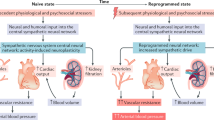Abstract
The Dahl salt-sensitive (DS) and salt-resistant (DR) rat lines were selectively bred to show opposite genetically determined blood pressure responses to excess sodium chloride ingestion. These animals have provided significnat anatomical, physiological, and biochemical data concerning the pathological mechanisms of experimental hypertension. Research is also being conducted to determine the relevance of psychobiological and behavioral variables in these two lines. The rationale for the selection and maintenance of the Dahl model and the physiological, biochemical, and behavioral characteristics which distinguish DS and DR rats are presented. Although originally developed for the study of salt-induced hypertension, special attention is given to the application of this animal model in behavior genetic research, stressing its inherent advantages and limitations. The use of the Dahl model in psychobiological studies and the utility of the model for future behavioral, genetic, and psychophysiological research are also detailed.
Similar content being viewed by others
References
Ben-Ishay, D., and Welner, A. (1969). Sensitivity to experimental hypertension and aggressive reactions in rats.Proc. Soc. Exp. Biol. Med. 132:1170–1173.
Blizard, D. A. (1979). Autonomic, biochemical and behavioral reactivity in the Maudsley Reactive and Nonreactive strains.Behav. Genet. 9:439–440.
Blizard, D. A. (1981). The Maudsley Reactive and Nonreactive strains: A North American perspective.Behav. Genet. 11:469–489.
Broadhurst, P. L. (1960). Applications of biometrical genetics to the inheritance of behaviour. In Eysenck, H. J. (ed.), Experiments in personality, Vol. 1, Psychogenetics and Psychopharmacology, Routledge and Kegan Paul, London, pp. 1–102.
Cohen, D. H., and Obrist, P. A. (1975). Interactions between behaviour and the cardiovascular system.Circ. Res. 37:693–706.
Dahl, L. K. (1972). Salt and hypertension.Am. J. Clin. Nutr. 25:231–244.
Dahl, L. K. (1977). Salt intake and hypertension. In Genest, J., Koiw, E., and Kuchel, O. (eds.),Hypertension, McGraw-Hill, New York.
Dahl, L. K., and Heine, M. (1975). Primary role of renal homografts in setting chronic blood pressure levels in rats.Circ. Res. 36:692–696.
Dahl, L. K., and Love, R. A. (1957). Etiological role of sodium chloride intake in essential hypertension in humans.J. Am. Med. Assoc. 164:397.
Dahl, L. K., Heine, M., and Tassinari, L. J. (1962). Effects of chronic excess salt ingestion. Evidence that genetic factors play an important role in susceptibility to experimental hypertension.J. Exp. Med. 115:1173–1190.
Dahl, L. K., Heine, M., and Tassinari, L. J. (1963). Effects of chronic excess salt ingestion. Role of genetic factors in both DOCA-salt and renal hypertension.J. Exp. Med. 118:605–617.
Dahl, L. K., Heine, M., and Tassinari, L. J. (1965). Effects of chronic excess sodium ingestion. Further demonstration that genetic factors influence the development of hypertension: Evidence from experimental hypertension due to cortisone and to adrenal regeneration.J. Exp. Med. 122:533–545.
Dahl, L. K., Knudsen, K. D., Heine, M., and Leitl, G. (1968). Hypertension and stress.Nature 219:735–736.
Dahl, L. K., Knudsen, K. D., and Iwai, J. (1969). Humoral transmission of hypertension: Evidence from parabiosis.Circ. Res. 24/25 (Suppl. I):21–33.
Eichelman, B., DeJong, W., and Williams, R. (1973). Aggressive behavior in hypertensive and normotensive rat strains.Physiol. Behav. 10:301–307.
Friedman, R., and Dahl, L. K. (1975). The effect of chronic conflict on the blood pressure of rats with a genetic susceptibility to experimental hypertension.Psychosom. Med. 37:402–416.
Friedman, M., and Freed, S. C. (1949). Microphonic manometer for the indirect determination of systolic blood pressure in the rat.Proc. Soc. Exp. Biol. Med. 70:670–672.
Friedman, R., and Iwai, J. (1976). Genetic predisposition and stress-induced hypertension.Science 193:161–162.
Friedman, R., and Iwai, J. (1977). Dietary sodium, psychic stress and genetic predisposition to experimental hypertension.Proc. Soc. Exp. Biol. Med. 155:449–452.
Friedman, R., and Weiss, K. R. (1974). Avoidance behavior of two strains of rats with opposite genetic susceptibility to experimental hypertension.Psychophysiology 11:222–223.
Friedman, R., Haber, S. B., and Iwai, J. (1978). Behavioral correlates of genetic predisposition to experimental hypertension.Behav. Genet. 8:92 (abstract).
Friedman, R., Tassinari, L. J., Heine, M., and Iwai, J. (1979). Differential development of salt-induced and renal hypertension in Dahl hypertension-sensitive rats after neonatal sympathectomy.Clin. Exp. Hypertens. 1:779–799.
Haber, S. B., Friedman, R., and Iwai, J. (1979). A genetic analysis of the relationship between behavior and blood pressure sensitivity.Behav. Genet. 9:454–455.
Henry, J. P., and Stephens, P. M. (1977).Stress, Health and the Social Environment, Springer-Verlag, New York.
Ikeda, T., Tobian, L., Iwai, J., and Goossens, P. (1978). Central nervous system pressor responses in rats susceptible and resistant to sodium chloride hypertension.Clin. Sci. Mol. Med. 54:225S.
Kempner, W. (1948). Treatment of hypertensive vascular disease with rice diet.Am. J. Med. 4:545.
McCarty, R., and Kopin, I. J. (1979). Patterns of behavioral development in spontaneously hypertensive rats and Wistar-Kyoto normotensive controls.Dev. Psychobiol. 12:239–243.
Ohanian, E. V., Dahl, L. K., and Iwai, J. (1976). Genetic influence on hypertension induced by cadmium in Dahl hypertension-resistant and hypertension-sensitive rats. In Hemphill, D. D. (ed.),Trace Substances in Environmental Health. X. A Symposium, University of Missouri, Columbia, pp. 451–457.
Rapp, J. P., and Iwai, J. (1976). Characteristics of rats selectively bred for susceptibility or resistance to the hypertensive effect of high salt diet.Clin. Exp. Pharmacol. Physiol. Suppl. 3:11–14.
Slater, J., Blizard, D. A., and Pohorecky, L. A. (1977). Central and peripheral norepinephrine metabolism in rat strains selectively bred for differences in response to stress.Pharmac. Biochem. Behav. 6:511–520.
Weiner, H. (1976).Essential hypertension and psychosomatic research.Psychosom. Med. 38:1–3.
Weiner, H. (1977).Psychobiology and Human Disease, Elsevier, New York.
Author information
Authors and Affiliations
Additional information
This article has been authored under Contract EY-76-C-02-0016 with the U.S. Department of Energy.
Rights and permissions
About this article
Cite this article
Haber, S.B., Friedman, R. Psychobiology of experimental hypertension: Evaluation of the Dahl rat lines. Behav Genet 11, 505–515 (1981). https://doi.org/10.1007/BF01070006
Received:
Accepted:
Issue Date:
DOI: https://doi.org/10.1007/BF01070006




